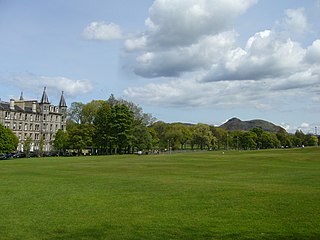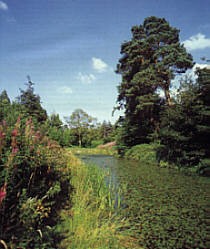 W
WBruntsfield Links is 35 acres (14 ha) of open parkland in Bruntsfield, Edinburgh, immediately to the south-west of the adjoining Meadows.
 W
WCammo is a north-western suburb of Edinburgh, the capital of Scotland. It is south of A90, at the edge of the city, approximately 6 miles from the city centre.
 W
WCorstorphine Hill is a low ridge-shaped hill rising above the western suburbs of Edinburgh, Scotland. Although there has been residential and commercial development on its lower slopes, especially in the south and west, most of the hill is occupied by a local nature reserve, consisting of extensive broadleaf woodland, and is accessible to the public. The hill, which is composed largely of dolerite, was formed by the west-to-east movement of glaciers during the Pleistocene period. There is evidence of prehistoric settlement. Today the hill is popular with walkers, dog-walkers and joggers. Among its interesting features are a 19th-Century tower, a walled garden and a Cold War bunker.
 W
WThe Hermitage of Braid is an area between the Braid Hills and Blackford Hill. The Braid Burn runs through it. It comprises part of the 60.3-hectare (149-acre) Hermitage of Braid and Blackford Hill Local Nature Reserve.
 W
WHolyrood Park is a royal park in central Edinburgh, Scotland about 1 mile to the east of Edinburgh Castle. It is open to the public. It has an array of hills, lochs, glens, ridges, basalt cliffs, and patches of gorse, providing a wild piece of highland landscape within its 650-acre (260 ha) area. The park is associated with the royal palace of Holyroodhouse and was formerly a 12th-century royal hunting estate. The park was created in 1541 when James V had the ground "circulit about Arthurs Sett, Salisborie and Duddingston craggis" enclosed by a stone wall.
 W
WInverleith is an inner suburb in the north of Edinburgh, Scotland, on the fringes of the central region of the city. Its neighbours include Trinity to the north and the New Town to the south, with Canonmills at the south-east and Stockbridge at the south-west. Like a great many places in and around Lothian and Edinburgh, the name comes from Scottish Gaelic – Inbhir Lìte, meaning "Mouth of Leith", as with Inverness, meaning mouth of the River Ness. Some documents refer to the area as "Inner Leith".
 W
WLauriston Castle is a 16th-century tower house with 19th-century extensions overlooking the Firth of Forth, in Edinburgh, Scotland. It lies on Cramond Road South, between Cramond, Davidson's Mains, and Silverknowes. The substantial grounds, Lauriston Castle Gardens, operate as a local park. The castle was bequeathed to the Edinburgh Corporation and hosts the Lord Provost's annual Garden Party. The house is a Category A listed building and the grounds are included in the Inventory of Gardens and Designed Landscapes in Scotland.
 W
WLeith Links is the principal open space within Leith, the docks district of Edinburgh, Scotland. This public park is divided by a road into two main areas, a western section and an eastern section, both being largely flat expanses of grass bordered by mature trees. Historically it covered a wider area extending north as far as the shoreline of the Firth of Forth. This area of grass and former sand-dunes was previously used as a golf links.
 W
WLochend Park is a public park in Edinburgh, Scotland. It is situated in the Lochend / Restalrig area, next to Lochend Castle and near Meadowbank Stadium. The loch with its wide range of waterfowl is the main attraction, but there are also historical buildings, a children's play area, and sports areas. The park was awarded a Green Flag in 2012 in recognition of it being a quality greenspace. Within the park there is a 16th-century doocot which is Category B listed.
 W
WThe Meadows is a large public park in Edinburgh, Scotland, to the south of the city centre.
 W
WPrinces Street Gardens are two adjacent public parks in the centre of Edinburgh, Scotland, lying in the shadow of Edinburgh Castle. The Gardens were created in the 1820s following the long draining of the Nor Loch and building of the New Town, beginning in the 1760s.
 W
WThe Royal Botanic Garden Edinburgh (RBGE) is a scientific centre for the study of plants, their diversity and conservation, as well as a popular tourist attraction. Founded in 1670 as a physic garden to grow medicinal plants, today it occupies four sites across Scotland—Edinburgh, Dawyck, Logan and Benmore—each with its own specialist collection. The RBGE's living collection consists of more than 13,302 plant species, whilst the herbarium contains in excess of 3 million preserved specimens.